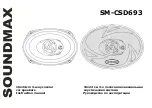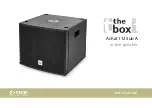
5
Handmade Cabinets
Our cabinet department hand assembles each
unit, and then hand sands each several times.
The result is a cabinet of exceptional workman-
ship, with sharp corners and smooth sides.
Veneers
We use premium, book-matched veneers in our
oiled cabinets, chosen for grain consistency and
aesthetics. A pair of speakers uses wood veneer
from the same tree, so grain patterns are con-
sistent. Our cabinet shop sequences the veneer,
maintaining a match for the top, right/right,
and left/left sides of each pair of speakers. We
even go so far as to veneer the inside of the
cabinet. This way, as the cabinet experiences
changes in humidity in your home, it won’t
warp or come apart at the edges.
Placement Switch
This switch ”normalizes“ the speaker when it is
placed in a cabinet or next to a large object,
like a big-screen TV. This Snell feature assures
predictable performance of your speaker in
everyday settings.
Heat Sink / Terminal Plate
Available on the E.5mk2 Tower and
K.5mk2 Monitor
Heat-producing crossover components are
mounted to a die-cast aluminum heat sink for
stable, consistent performance at high power.
This large heat sink also draws heat from inside
the cabinet, keeping critical driver components
cooler. The terminal plate has two sets of five-
way gold-plated binding posts for bi-wiring or
bi-amplifying.
Rear-Firing Tweeter
The rear-firing tweeter on the E.5mk2 Tower
adds necessary high-end ”fill“ to the sound-
stage, creating a broader, deeper stereo image
when the speaker is placed away from a back
wall. An on/off switch allows you to defeat the
rear tweeter when the E.5mk2 is placed up
against a back wall.
Platform Baffle
This three-layer sandwich isolates the baffle
from the cabinet to decrease panel resonances
and distortion
—
especially in the critical
midrange. The Platform Baffle consists of mate-
rials of varying density
—
an extremely dense
outer layer to which the tweeter and bass units
are mounted, a ”squishy“ neoprene middle
layer, and a medium-density inner layer which
attaches to the cabinet.
Radiused-Edge Baffle
The elliptical radius on our baffle edge reduces
re-radiation for a cleaner and smoother
response
—
especially off-axis. Snell pioneered
this technique in the original Type A speaker
system in 1976.
Grille Design
The custom-perforated metal grille has no
frame to cause degrading reflections in the
upper frequencies. Rubber mounts isolate the
grille posts from the Platform Baffle.
Hand-Tuned Crossover
These networks adhere to an “in-phase” or
Linkwitz Reilly design. (Time alignment and
coherency are achieved through the transition
region from driver to driver.) Each crossover is
individually tuned by our technicians to within
±0.5dB of the Master Reference, assuring pre-
dictable performance in your home.
1
2
3
4
5
6
7
8
9
8
7
4






























